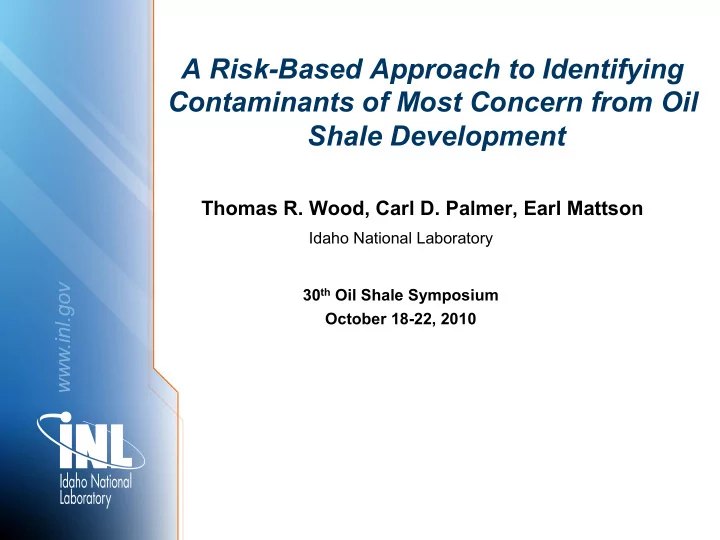

A Risk-Based Approach to Identifying Contaminants of Most Concern from Oil Shale Development Thomas R. Wood, Carl D. Palmer, Earl Mattson Idaho National Laboratory www.inl.gov 30 th Oil Shale Symposium October 18-22, 2010
Objective: To determine which contaminants are likely to be of most concern with regard to in-situ oil shale development. Approach: • Identify contaminants reported from laboratory leaching tests and from groundwater sampling at field retort tests, • Estimate the relative toxicity of the contaminants, • Estimate the mobility of those contaminants.
Groundwater Contaminant Data Sources Organics Linder-Lunsford (1990) MFG Environmental (2006) Benton (1992) Inorganics MFG Environmental (2006) Palmer and Mattson (Unpublished data) Parker et al. (1976) Linder-Lunsford (1990) Benton (1992) Fox (1979) Jackson et al. (1975)
Organic Contaminants 79 Reported Compounds • phenols (2,4-dimethylphenol) • ketones (2-butanone) • alcohols (2-ethyl-2-hexanol) • organic acids (benzoic acid) • aromatics (benzene) • nitrogen compounds (pyridine) • alkanes (trimethylcyclohexane) • PAHs (phenanthrene) • halogenated compounds (tribromophenol)
Inorganic Contaminants 70 Reported Compounds • pH • Metals (Zn, Ni) • Alkali/Alkaline Earths (Na + , K + , Ba 2+ ) • Nitrogen compounds (NH 4 + ) • Sulfur compounds (SO 4 2- , S 2- ) • Halides (Cl - , Br - , F - ) • Oxyanions (Sb, B) • Rare Earth Elements (Zr, Y) • Cyanide • Uranium
Estimate “Toxicity” • obtain maximum reported aqueous concentration (C max ), • determine some “safe” contaminant concentration (C MCL ) • drinking water standards (EPA) • secondary drinking water standards (EPA) • state drinking water standards/guidelines • foreign drinking water standards/guidelines (Canada, UK, EU) • Identify (e.g., from ATSDR) an oral Maximum Risk Level (MRL) or similar criterion (in mg/kg/day) and multiply by 45 kg, divide by 3.7 L/day, and divide by 10. • divide C max by C MCL
Estimating “Mobility” • Estimate retardation factor • Mobility = 1/R
Neutral, hydrophobic organic compounds 14 ρ Phenanthrene Sorption b R 1 K Sorbed Concentration (mg/g) = = + + onto Green River Kerogen 12 p θ w 10 C K C = s p aq 8 K p = 15631 ±814 mL/g K oc = 43662 ±2273 mL/g K f K = 6 p oc oc Data from Salloum et al. (2002) 4 0.0 0.1 0.2 0.3 0.4 0.5 0.6 R retardation factor = Aqueous Concentration (mg/L) K soil partition coefficient = p f fraction of organic carbon in soil = oc K partition coefficient between aqueous phase = oc and soil carbon phase
Neutral, hydrophobic organic compounds 1800 600 K (Karickhoff, 1981) p ρ P 1500 R 1 b K 500 H ) = = + + E g Slope = K oc / N p L A θ 1200 400 m N ( w T E H N 900 PYRENE R 300 K f K E = E R N p oc oc Y E 600 P 200 ( m p K L 300 / 100 g R retardation factor PHENANTHRENE = ) 0 0 0.0 0.005 0.010 0.015 0.020 0.025 K soil partition coefficient = FRACTION ORGANIC CARBON p f fraction of organic carbon in soil = oc K partition coefficient between aqueous phase = oc and soil carbon phase
Neutral, hydrophobic organic compounds 7 6 Empirical and Structure- 5 Log K oc based relationships 4 between K oc and the 3 octanol-water partition 2 coefficient (K ow ) 1 Data from Karickhoff (1981) 0 0 1 2 3 4 5 6 7 8 Log K ow
Toxicity and Mobility 0 Low Toxicity, High Toxicity, High Mobility High Mobility Log(1/R) -2 Low Toxicity, High Toxicity, Low Mobility Low Mobility -4 -6 -2 -1 0 1 2 3 4 Log(C max /C MCL )
Organic Compounds 0 Log(1/R) -2 -4 -6 -2 -1 0 1 2 3 4 Log(C max /C MCL )
Organic Compounds of Most Concern Benzidine Pyrrole Benzene 2-Methylnaphthalene 1-Methylnaphthalene Isophorone 2-Butanone Chloroethane Aniline 2-pyrrolidone 2-methylphenol vinyl chloride 3- and 4- Methylphenol Bromomethane acetonitrile 4-methylphenol Phenol Acetone Thiophene 2-Hexanone
Organic Compounds of Potential Concern 1,1,3 trimethyl Cyclohexane 6-octen-2-one 1,3 dihydro 2-H-Indol, 2-one 7-octen-2-one 2(1,1-dimethlethyl)-3-methyl oxirane Beta-citronellol 2,6 dimethyl 5-hepten-1-o1 decahydro-1-methyl quinoline 3,3-dimethyl butanoic acid dihydro-5-methyl 2(3H)-furanone 3-ethyl, 4-methyl, 2,5 furandione dihydro-5-propyl furanone 3-methyl Bicyclo[4,1,0]heptane Ketones (sum) 3-methyl cyclopentacarbonic acid N-ethyl-4-methyl benzensulfanilimide 4,4,6-trimethyl 2-cyclohexen-1-one trans-1, 6-dimethylbicyclo[4.3.0]nonan 4-ethyl, 3-heptene N-methyl ethanamine 4-hepten-2-ol Methane 4-Methyl-2-pentanone Ethene 5-chloro-2-2hydroxy Benzaldehyde 1-H-Benzotrizole 5-methyl 1-hepten Pentanoic acid 5-methyl-2(1-methylethyl) cyclohexanol hexanoic acid 6-methyl 2-heptanone
Temperature Dependence of Log(K ow ) Chlorobenzenes 6.0 Hexa- 5.5 5.0 Similar results for monoterpenoids log (K ow ) (Copolovici and Niinemets, 2005) 4.5 1,3,5-tri- and sulfonamides (Congliang, et al. 4.0 (2007). 3.5 1,2-di 3.0 Data from Bahadur et al.,1(997) 2.5 0.0031 0.0032 0.0033 0.0034 0.0035 0.0036 0.0037 1/T
Inorganic Compounds 0 Log(1/R) -2 -4 -6 -2 -1 0 1 2 3 4 Log(C max /C MCL )
Inorganic Compounds of Most Concern Ammonia Cyanide Sulfide Sulfate Boron Chloride Sodium Mercury iodide Vanadium Carbon disulfide Nitrite (N) Aluminum thiosulfate Fluoride thiocyanate TDS
Inorganic Compounds of Potential Concern Bicarbonate tungsten Magnesium praseodymium Total Alkalinity lanthanum Oil and Grease neodymium Total Organic Carbon germanium COD gallium Bromide titanium lithium scandium
Summary We have • Obtained data (field and laboratory) on maximum concentrations associated with leaching of spent oil shale, • Considered the risk of these contaminants based on their relative mobility and toxicity, • Created an initial prioritized list of contaminants that should be considered, • Identified potential contaminants that require additional information.
Limitations with the Approach • Use of maximum observed concentrations, • How to include frequency of occurrence, • Insufficient guidelines for MCLs, • Lack of octanol/water partition data, • Partition coefficients are a function of temperature, • Have not included potential biodegradation, • Have yet to include potential mineral precipitation, • Potential for colloidal transport, • Additional difficulties with fracture flow.
Recommend
More recommend